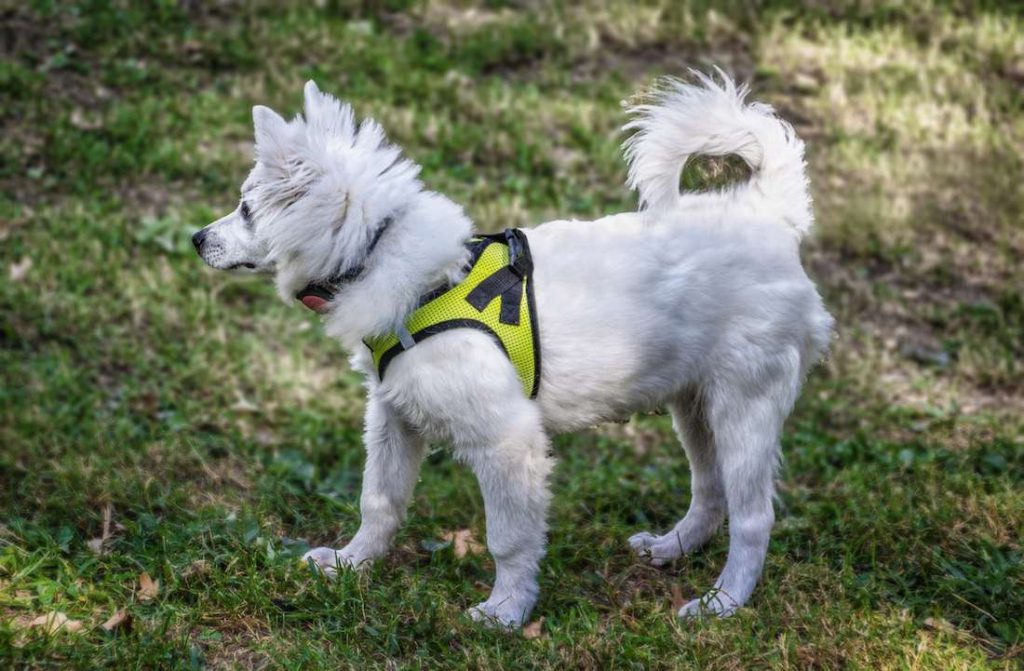Most loving pet parents can tell you a lot about their pooch by the movements of his tail. It’s an important part of his personality, and it plays an important role in a dog’s body language. It’s part of at least what you think you know about the emotional state of your dog.
But is it really? Why exactly do dogs have tails in the first place, and what do they use them for? Let’s explore what scientists know about the evolution and function of tails and how domestication may have affected this much beloved physical trait.
Why Do Any Animals Have Tails?

Tails are a characteristic of animals in the phylum Chordata, also known as vertebrates, meaning animals with backbones. One of the defining characteristics of animals in this category is the presence of a flexible tail that supports their back sides.
There are some other types of animals that have tails, but the majority are in this category. Moreover, the tails present on animals are diverse in function and shape. There are long tails, short tails, curly tails, straight tails, and even stumpy tails.
Many animals use their tail like a fifth limb for propulsion, stability, and enhanced maneuverability. It is used by some animals to warn other animals they’re crossing a line, or to let potential mates know of their desire to get a little closer.
There are also some animals that can use their tails to help regulate their body temperature (they wrap their tail around them to keep warm, though, for some dogs, this isn’t enough), store energy, and grab ahold of branches as they swing through the trees. In essence, for some animals, the tail is critical for their survival. But what about dogs? Why do dogs have tails?
Why Do Dogs Have Tails?

Many experts have hypothesized on the reasons dogs have tails, but there is relatively little research conducted into this question. And more specifically, what effects domestication has had on the function of tail wagging.
Dogs do not climb in the trees as many primate species do. Thus, it is not used as an extra appendage for navigating such a complex environment. So, what exactly is the role a dog’s tail serves?
To better understand why dogs have tails, it’s important to consider ethologist Niko Tindbergen’s four questions:
- How did it evolve?
- How does it develop?
- How does it work?
- What is it for?
Let’s tackle these one at a time.
How Did the Dog’s Tail Evolve?
Dogs are part of the phylum Chordata. As such, their tail evolved long before their evolution into canids and their eventual domestication. Because canids, like dogs, don’t use their tail primarily for locomotion as other species do, like monkeys with prehensile tails. Their tail is used more for ritualized communication.
Research suggests that dogs were first domesticated more than 20,000 years ago. Archaeologists believe that a mutualistic relationship developed between wolves scavenging the remains of nomadic human camps and the human inhabitants of those camps, leading to domestication. The theory goes that the wolves benefitted from the food nomads inevitably discarded. In turn, humans benefitted from the wolves’ presence because they warned of the approach of other predators and unfamiliar human groups.
The humans encouraged the wolves to follow the camp by giving them food. Eventually, they began to manipulate the reproduction of the canids. They did this to reduce the danger the animals posed to them. The resulting genetic changes led to smaller canids with friendlier temperaments and less dangerous physical characteristics (i.e., smaller canine teeth).
Over time, humans began to further manipulate the reproduction of their canine friends, which eventually produced the different breeds of dogs. Tail-wagging, then, became a communicative function to indicate the dog’s internal emotional state. Something it would benefit the humans to know.
How Did Tail-Wagging Behavior Develop?

Canids of all kinds have tails, but there is a distinct difference between domesticated dog tail-wagging behaviors and the tail-wagging behaviors of other canids. While the use of the tail for communication varies greatly in different breeds of dogs, between the sexes, and in different individuals, domesticated dogs wag their tails much more than any other canid.
Between dogs and wolves, for example, the differences in tail-wagging emerge as early as three weeks of age. This is true even when the two are raised in the same way. Whereas the domesticated dogs began wagging their tail at this early age, wolf pups almost never did. That suggests the possibility that the domestication process itself might have resulted in the favorable selection of tail-wagging in the context of interacting with humans.
That is in line with yet another study that demonstrated adult beagles shifted from a left to a right-side bias as the dog became more familiar with the human experimenter conducting the test. Thus, it appears that the increased and side-biased tail-wagging behavior of dogs is the result of their interactions with humans.
How Does a Dog’s Tail Work?
As with other vertebrates, the dog’s tail is an extension of his spine, but relatively little is known about how tail movements are actually controlled. Experts assume the cerebellum is involved in tail movement. When they electrically stimulate certain parts of the cerebellum, there is an increase in tail wagging.
Moreover, dog tail wagging is asymmetric. This means that a dog’s tail will wag on one side or the other depending on what stimulates their behavior. Happy dogs show a right-side bias to their tail-wagging. In aggressive or frightening situations, such as meeting a dominant dog, they show a left-side bias to their wagging.
Research using robotic dogs shows that dogs are able to perceive the side bias to tail-wagging behavior in other dogs. This demonstrates the importance of the tail position in communicating various emotional states.
Other studies have also documented a link between the time a dog spends wagging his tail and heart rate. Additionally, researchers argue that the link between both positive and negative arousal states and tail-wagging behavior suggests that certain arousal-related hormones and neurotransmitters are correlated with how your dog wags his tail.
All of this suggests clear evidence of neurological control of the dog’s tail, but exactly how everything works in conjunction with the behavior is still unclear.
What Is Dog Tail Wagging For?
It appears that domesticated dog tail-wagging is mainly used for complex communication with humans and other domesticated dogs. It’s not just the tail wagging either; it’s also the tail carriage or position that matters.
Additionally, the presence of the anal glands, which are used for scent communication such as territory marking. So what is your dog’s tail movements trying to tell you? Here is what the research shows:
- Low carriage (tail position): This is a visual sign of submission, appeasement, or non-aggressive intentions. Your dog might also put his tail between his legs to indicate submission. These actions serve to reduce the scent from the anal glands.
- High (vertical) tail position: This indicates aggression in dog-dog interactions and releases more scent from the anal glands. It also indicates an alert position, something you might see in hunting dogs and other types of working dogs. These include Australian Shepherds, German Shepherds, Labrador Retrievers, and Welsh Corgis.
- Combination of low carriage and tail-wagging: This indicates formal submission in dog-dog and dog-human interactions.
- Tail-wagging alone: This indicates appeasement or affiliative desires in dog-human interactions but can also indicate a positive response to non-social stimuli, such as food.
- Rate and force of tail-wagging: A tiny, high-speed wag may indicate a readiness for action, and if your dog’s tail is held high while wagging rapidly, that could indicate an active threat. If, however, your dog’s tail is in a neutral or slightly raised position and wagging fast, that indicates a happy dog. A slow wag, or if your dog stops wagging his tail and freezes in place, might mean he is trying to fend off what he perceives as a threat without being aggressive. Finally, if your dog’s tail wags so fast that it seems to vibrate, that could indicate he is excited.
- Horizontal position: This often indicates your dog is curious about something.
Do Dogs Wag Their Tail to Help with Balance?

According to the American Kennel Club (AKC), a dog’s tail is used as a counterweight to help him with balance, particularly if he’s navigating a narrow surface or running. Recent research from the Max Planck Institute, however, shows that is not the case.
Their study analyzed the movements of border collies fitted with technologically advanced suits. The suits held sensor beads to track the movements of every part of the dog’s body parts. After completing a series of agility exercises, the researchers could then map those data onto virtual dogs.
By creating virtual dogs, the researchers could remove the tails and see if the computer models predicted significant differences in the dog’s abilities. There was very little difference between dogs with tails and those without tails.
Additionally, dogs’ tails are smaller than tree-dwelling creatures, like monkeys, that use tails for stabilization in that environment. They are also less agile than ground-dwelling creatures that use tails for stabilization when they are running fast, like cheetahs. The researchers concluded that, given these results, the dog’s tail is likely used mainly for communication as opposed to stabilization.
How Does a Short or Docked Tail Affect Dog Communication?
If a dog’s tail is used mainly for communication, what happens if you dock a dog’s tail or he has an accident and loses his tail or the ability to wag it? Recent research attempted to answer that question by observing dogs in dog parks and using robot dogs with long and short tails to see what, if any, effects a shorter tail had on communication.
The study first observed encounters between dogs of all kinds in dog parks. Some 53% of aggressive encounters involved dogs with short tails. To address the possible criticism that many short-tailed dogs are working dogs with more aggressive natures like Rottweilers, for example, the researchers then utilized robot dogs with both long and short tails.
First, they used the robotic dog with a long tail in different positions to verify that living dogs would react to it as they would another dog. Once affirmed, they then used a robotic dog with a short tail to see what effect the tail length had on the interaction.
Living dogs approached the robotic short-tailed dog much more cautiously than the one with a long tail. This was true even when the short-tailed dog’s tail was moving in a way that indicated friendliness or submissiveness.
Having a short or long tail does not seem to affect dog-human interactions, but these results suggest that dogs with short tails may be at a communicative disadvantage when interacting with other dogs.
Talk to the Tail
Research indicates that a dog’s tail is as important or more important than facial expression for communication. So, the next time you want to know how your dog is feeling, just take a look at his tail!
